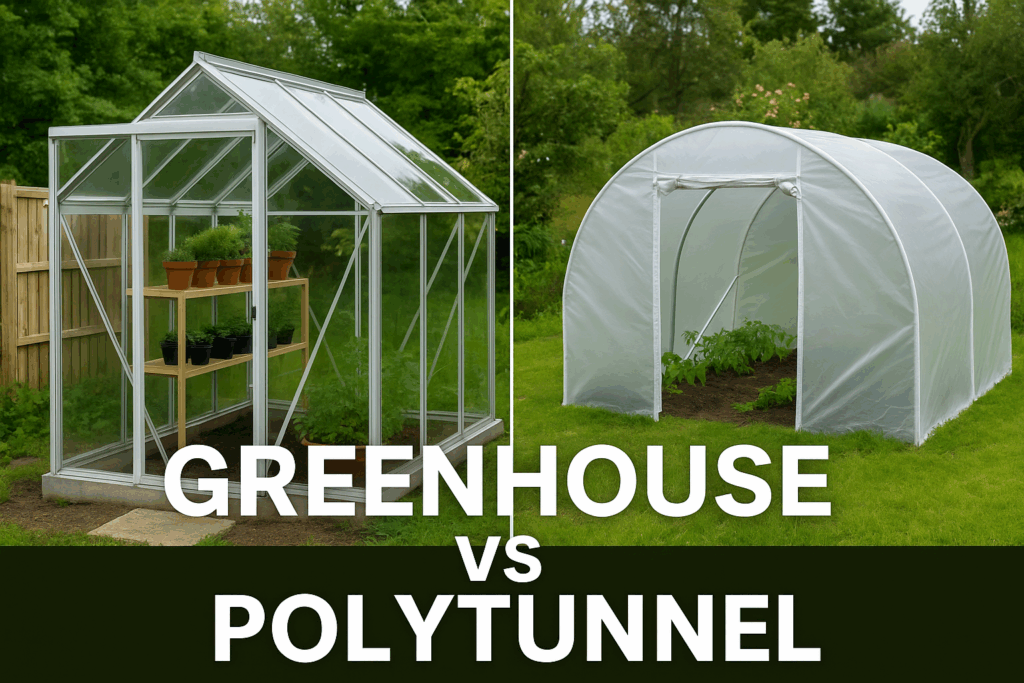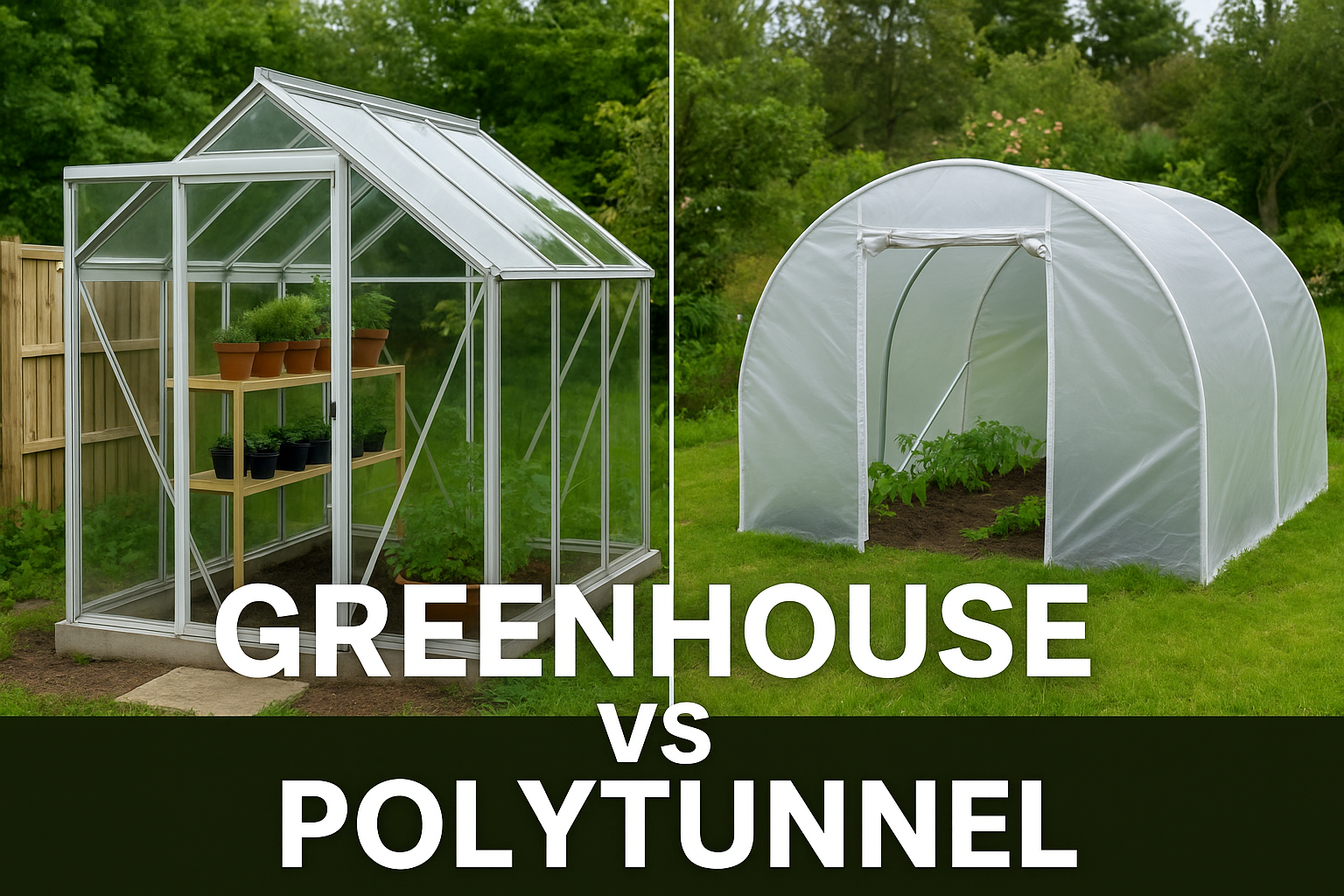
Introduction
If you want to grow crops for longer in the UK, a protected structure makes all the difference. Both greenhouses and polytunnels shield plants from wind, rain and frost while trapping warmth and light. But which one suits your space, budget and gardening style best?
This guide compares greenhouse vs polytunnel in terms of cost, temperature control, durability, maintenance and growing style so you can confidently decide which is right for your garden or allotment.
Looking for more guides and comparisons? Visit our Greenhouses & Polytunnels UK Resource Hub for everything from mini models to full-size structures.
If you want more information about greenhouses and polytunnels, check out our other guides:
What They Have in Common
Greenhouses and polytunnels share the same goal — providing a stable, sheltered microclimate that extends the growing season. Both:
- Allow sowing weeks earlier in spring and harvesting later into autumn.
- Protect crops from harsh weather and pests.
- Help maintain humidity and warmth for steady growth.
- Support similar crops — tomatoes, cucumbers, peppers, lettuce, herbs, strawberries and more.
Key Differences at a Glance
Key Differences at a Glance
| Feature | Greenhouse | Polytunnel |
|---|---|---|
| Material | Glass or polycarbonate panels in an aluminium or wooden frame | Polythene sheet stretched over steel hoops |
| Setup | Fixed to a solid, level base | Can be installed on bare soil and moved later |
| Insulation | Excellent – retains heat longer overnight | Good – warms quickly but cools faster |
| Aesthetics | Attractive garden feature with clear walls | Functional, allotment-style appearance |
| Cost | Higher initial outlay | Lower cost per square metre |
| Maintenance | Occasional glass or panel replacement | Polythene cover replacement every 5–10 years |
| Best for | Potted plants, propagation, ornamentals | In-ground or raised-bed vegetable growing |
Cost and Space: What You Get for Your Money
Prices vary widely depending on size and materials, but for UK buyers in 2025 this is a realistic guide:
| Size | Greenhouse (typical price) | Polytunnel (typical price) | Notes |
|---|---|---|---|
| Mini (under 4 ft) | £40 – £120 | £25 – £60 | Mini greenhouses often include shelves for seed trays; mini polytunnels sit over beds and are easy to lift off. |
| Small (4–6 ft) | £100 – £250 | £60 – £150 | Greenhouses use staging for pots; small polytunnels suit raised beds and salad crops in soil. |
| Medium (6×8 ft – 8×10 ft) | £250 – £700 | £120 – £350 | Typical “family” size. Greenhouses cost roughly double for similar growing space. |
| Large (10 ft + walk-in) | £600 – £2,000 + | £200 – £800 + | Polytunnels offer 1.5–2 × more space per £ — ideal for allotments and bulk veg growing. |
💡 Rule of thumb: for the same budget, a polytunnel usually provides twice the growing area of a greenhouse.
Layout differences:
– Greenhouses make use of vertical shelving, perfect for seedlings and propagation.
– Polytunnels are designed for in-ground growing; smaller ones can even be lifted off to weed, water, or harvest.
Climate Control and Overheating
Ventilation and shading are crucial for both structures.
- Greenhouses often have roof or side vents, and automatic openers make temperature control effortless.
- Polytunnels depend on manual airflow — rolling up the sides or propping open doors at each end.
In hot weather, both can overheat quickly. Shading nets, whitewash, or opening all vents help maintain the ideal 20–28 °C range. For a full guide, see our upcoming article How to Stop a Greenhouse or Polytunnel Overheating in Summer.
During winter, greenhouses retain heat longer, while polytunnels benefit from an extra layer of bubble wrap or fleece for insulation.
Durability and Maintenance
- Greenhouses: glass can last for decades if cared for, though panes may break in storms. Polycarbonate panels are safer but may cloud over time.
- Polytunnels: frames last many years; covers typically need replacing every 5–10 years depending on UV exposure and wind.
Routine maintenance for both includes cleaning algae from panels or plastic, checking seals, and tightening fittings each spring.
Weather Resistance
In exposed or coastal areas, a well-anchored greenhouse often handles strong winds better thanks to its rigid base.
Polytunnels can perform equally well if the cover is stretched tightly and secured with proper fixings.
For high-wind zones, choose reinforced tubing and consider adding windbreak mesh on the prevailing-wind side.
Aesthetics and Garden Integration
Greenhouses are undeniably neater and can double as a feature structure in ornamental gardens.
Polytunnels are more utilitarian but blend naturally into larger or working plots.
Many gardeners use both: a small greenhouse for propagation and a tunnel for bulk food crops.
Which Is Right for You? – Quick Decision Guide
- 🏡 Small garden or patio: a compact greenhouse maximises vertical space and looks tidy.
- 🌾 Large garden or allotment: a polytunnel gives more growing area for your budget.
- 🌬️ Wind-exposed site: a sturdy polycarbonate greenhouse is the safer option.
- 💷 Tight budget: polytunnel offers best value per square metre.
- 🌺 Focus on ornamentals or display plants: greenhouse.
- 🥕 Focus on vegetables and rotation beds: polytunnel.
- 🚚 Need flexibility or might move plots: polytunnel is easier to dismantle and relocate.
What to Grow in Each
Greenhouse favourites: peppers, aubergines, basil, orchids, citrus, and young seedlings started early in spring.
Polytunnel crops: tomatoes, cucumbers, salad leaves, berries, melons, kale and other large or trailing plants that enjoy soil planting.
Conclusion
Both greenhouses and polytunnels extend the growing season, protect crops from unpredictable UK weather, and make home gardening more productive.
- Choose a greenhouse if you value appearance, structure, and precise climate control.
- Choose a polytunnel if you want maximum growing space and flexibility for your money.
Whichever you choose, the most productive gardeners often use both together — starting seeds in a greenhouse and moving them to a larger polytunnel for the main growing season.
For more self-sufficiency and gardening advice, explore our related guides:
👉 Best Type of Greenhouse – UK Guide
👉 Best Mini Greenhouses UK
👉 Best Small Greenhouses UK
Or visit the HomeGrower homepage for more practical tips on growing your own food, garden structures, and self-sufficiency ideas.
You can also check the Royal Horticultural Sochttps://www.rhs.org.uk/iety’s website for independent growing advice.
FAQs – Greenhouse vs Polytunnel
Is a greenhouse or a polytunnel better for beginners?
For beginners, both can work well, but in the greenhouse vs polytunnel debate, polytunnels usually win on simplicity and price. They’re easy to assemble, great for raised-bed growing, and forgiving if you make early mistakes. Greenhouses, however, are tidier and allow for more precise temperature control.
Which lasts longer – greenhouse or polytunnel?
When comparing greenhouse vs polytunnel lifespan, a well-built greenhouse can last for decades, especially with polycarbonate panels. A polytunnel’s frame is durable too, but its plastic cover usually needs replacing every 5–10 years depending on sun and wind exposure.
Which is cheaper – greenhouse or polytunnel?
Looking at cost, a polytunnel is far cheaper per square metre. The greenhouse vs polytunnel price gap grows with size: for the same budget, a polytunnel often gives twice the growing space of a greenhouse.
Do greenhouses and polytunnels get too hot in summer?
Yes — both can overheat in warm weather. In the greenhouse vs polytunnel comparison, greenhouses hold heat longer, while polytunnels warm faster but cool more quickly once ventilated. Shading, vents, or roll-up sides help maintain stable temperatures.
Which is better for winter growing – greenhouse or polytunnel?
For winter use, the greenhouse vs polytunnel choice depends on insulation. Greenhouses retain warmth better overnight, while polytunnels benefit from double layers or bubble-wrap lining. Both can grow hardy greens like spinach, lettuce, and herbs throughout the colder months.
Can I use both a greenhouse and a polytunnel together?
Yes — many UK gardeners do. A small greenhouse is perfect for seed starting and propagation, while a larger polytunnel provides extra space for crops once the weather warms. Combining both gives the best of both worlds.
Which works best in the UK climate – greenhouse or polytunnel?
In the greenhouse vs polytunnel debate for the UK climate, both perform well but suit different conditions. Greenhouses cope better in colder northern areas thanks to stronger insulation, while polytunnels excel in milder or wind-sheltered gardens where ventilation is easier. For most UK gardeners, the local microclimate — wind, shade and frost — matters more than latitude.
Which needs more maintenance – greenhouse or polytunnel?
When it comes to maintenance, the greenhouse vs polytunnel comparison is fairly even. Greenhouses may need occasional cleaning of glass or replacing broken panes, while polytunnels require new covers every few years and regular tension checks. Keeping both clean and well-ventilated reduces disease and helps plants thrive year-round.
